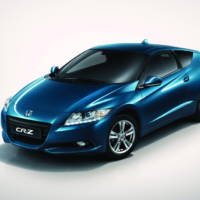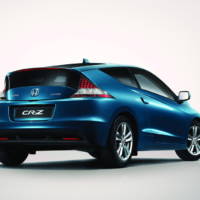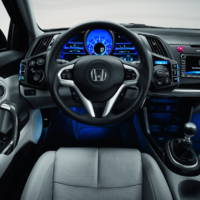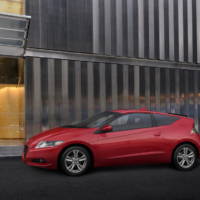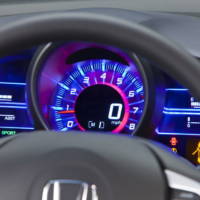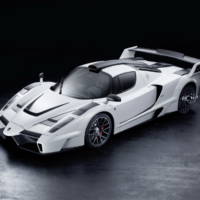The production version 2011 Honda CR-Z premiered at the 2010 NAIAS in Detroit, a vehicle that as the company say is set to change the current perception of hybrids.
The 2011 Honda CR-Z features a 2+2 coupe body with a driver-focused chassis and a 1.5 litre i-VTEC engine coupled to the Honda IMA parallel hybrid system. The 4-cylinder petrol engine delivers 124 PS and 174 Nm of torque while the electric motor provides an additional 14 PS and 78 Nm of torque. Sending power to the wheels is a 6-speed manual transmission and fuel consumption figures indicate the 2011 Honda CR-Z production version needs 5.0-litres of fuel per 100 Km with 117 g/Km CO2 emissions, meaning is in accordance with the Euro 5 standards.
At the exterior, unlike the US model, the European version 2011 Honda CR-Z will feature day time running lights with eight LEDs while at the interior both versions feature a two-level construction dashboard with controls placed close to the driver’s hands.
The 2011 Honda CR-Z price will be announced at a later date.
Honda press release :
The Honda CR-Z sports hybrid coupe debuts at 2010 Detroit Auto Show
The all-new Honda CR-Z has had its world premiere at the North American International Auto Show in Detroit. It is a unique new car, combining the advantages of a clean, efficient petrol electric hybrid powertrain with a 6-speed manual transmission and a stylish 2+2* coupe body. This exciting new coupe is set to change current perceptions of hybrids, with its driver-focussed chassis and responsive engine assisted by the IMA parallel hybrid system. The European version of the CR-Z will debut at the 80th Geneva International Motor Show in March 2010.
• World’s first 6-speed manual hybrid car
• Unique 3-Mode Drive System to tailor steering, throttle response and IMA assistance to the driver’s needs
• 1.5 litre i-VTEC engine coupled to the Honda IMA parallel hybrid system with 117 g/km** of CO2 and 5.0 l/100km fuel economy**
• All-new, sporty, aerodynamic, 2+2 coupe form
• Wide track, short wheelbase chassis for agile and responsive handling
• European market cars to be equipped with flexible 2+2 seating arrangement
The CR-Z ‘s exterior styling is formed around a “one-motion wedge” concept with a low bonnet line and wide stance giving the car a confident, athletic look. Signature Honda design features, such as the split level rear glass hatch and aerodynamic, shallow raked roofline have been referenced in the design of the sleek coupe and then combined with a curvaceous and deeply sculpted exterior form.
For the first time, a fuel efficient, low emission parallel hybrid system is combined with a precise and driver focussed 6-speed manual gearbox. The new CR-Z teams a conventional manual gearbox with a petrol-electric drivetrain for the first time since the 5-speed 2003 Civic IMA and is possible only because of the flexibility of Honda’s IMA parallel hybrid system.
The manual transmission is complemented by a 1.5 litre 4-cylinder engine, which is new to the EU and is a key component in the CR-Z’s unique character. The eager to rev nature of the medium capacity engine, is enhanced by the additional 78 Nm of torque provided by the 14 PS electric motor, which is situated between the engine and transmission.
The 1.5 litre engine combined with the power and torque of the IMA parallel hybrid system gives an overall power output of 124 PS and 174 Nm of torque. The peak torque figure is identical to that of the 1.8-litre Civic and with 35 g/km lower CO2 emissions of just 117 g/km**.
The electric motor gives the CR-Z an unusually flat torque curve with the maximum arriving at just 1500 rpm, unusually low for a naturally aspirated engine. Teamed with a 6-speed manual transmission, the IMA assisted engine provides great in-gear flexibility, excellent exhaust emissions and a sporty exhaust note.
To maximise driver choice and enhance the day to day drivability of the car, the CR-Z has been fitted with a 3-Mode Drive System. This unique feature allows the driver to choose between three driving modes, which alter the responses of the throttle, steering, idle stop timing, climate control and the level of assistance provided by the IMA system.
In developing this 3-Mode Drive System, Honda allows the driver to choose whether they wish to maximise enjoyment, economy or strike a balance between the two. Honda’s engineers wanted to give customers more choices in how the CR-Z would drive, depending on their needs and desires at the time.
Uniquely, the European version of the CR-Z has day time running lights with eight LEDs accenting the lower line of the sweeping headlights. This is the first time DTRL’s have been fitted to a production Honda, and combined with the EU only front fog lights provide a tailored look to the European specification CR-Z.
The shallow raked roofline and sharply truncated tail of the CR-Z is a feature shared with many Hondas past and present. This design allows the car to cut through the air with minimal disturbance, lowering fuel consumption and emissions. The European specification CR-Z has a 2+2 layout, enabling customers to carry smaller adults for short distances or children on longer journeys. The rear seats can be flattenned in a very simple one-touch motion to increase luggage capacity when it is needed.
The interior of the production car has been developed from the 2007 Tokyo Motor Show CR-Z Concept, with its 3D displays and driver focussed cabin. The high-technology instrument binnacle places all of the commonly used controls close to the driver’s hands, allowing full concentration on driving at all times.
The dashboard of the new coupe has a complex two-level construction, with a dark upper portion appearing to float above a light grey lower dash section, which continues into the centre of the inner door panels.
Driver enjoyment was a core part of the design brief and the CR-Z’s chassis plays a key role in creating the character of the car. The platform shares some components with the Insight, but the wheelbase, track width and set-up are all bespoke for the new hybrid. Forged aluminium MacPherson struts have been used in the CR-Z to reduce weight and increase strength over the pressed steel items used in the Insight.
Overall the CR-Z has a 115 mm shorter wheelbase and is 295mm shorter in overall length than the Insight, enhancing agility and reducing kerb weight by 44 kg compared to its 5-door, five-seat, family car cousin. The CR-Z suspension features new, spring and damper settings and the tolerances are individual to the compact coupe.
Video: 2011 Honda CR-Z production version
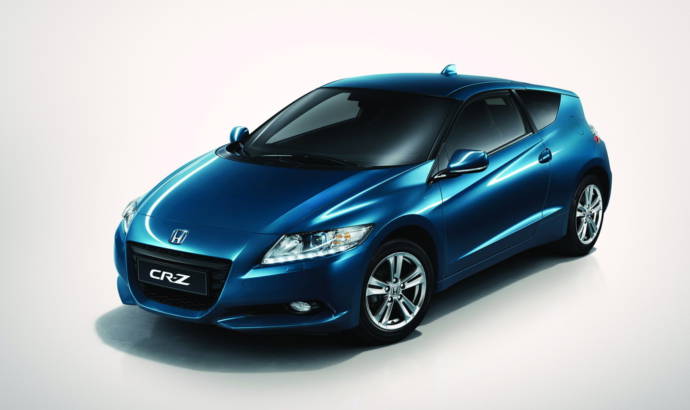
12 Jan 2010
0

